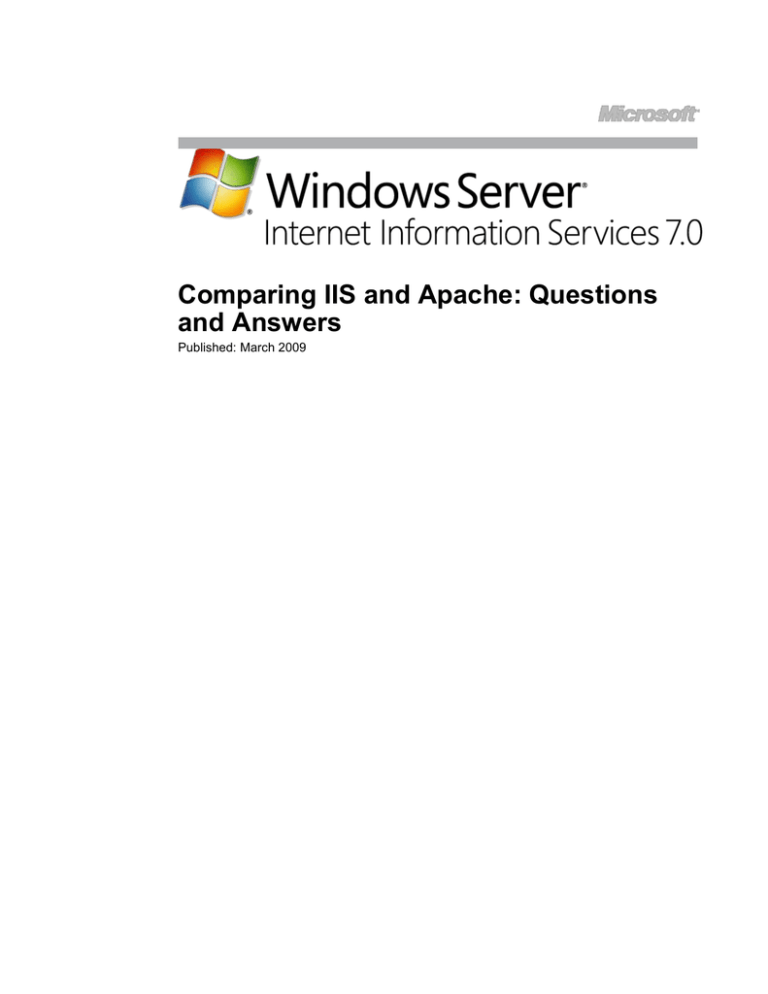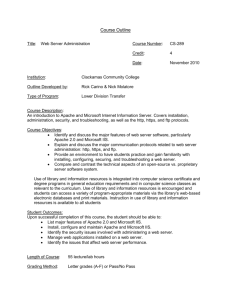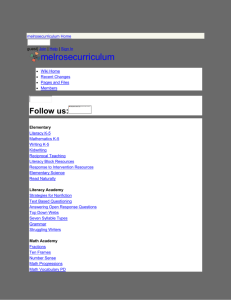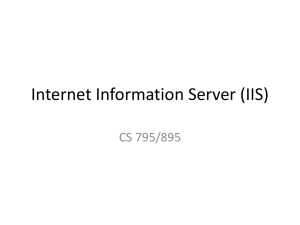
Comparing IIS and Apache: Questions
and Answers
Published: March 2009
Contents
Comparing IIS and Apache: Questions and Answers ................................................................1
Understanding IIS and Apache ...................................................................................................2
Apache HTTP Server .............................................................................................................2
Internet Information Server 6.0...............................................................................................2
Internet Information Services 7.0 ...........................................................................................3
Common Questions from Apache Administrators ......................................................................4
Does IIS offer the performance and scalability I need? .........................................................4
Is IIS as secure as Apache? ...................................................................................................4
Is IIS harder to manage than Apache? ..................................................................................5
Is IIS as reliable as Apache? ..................................................................................................5
Is IIS really as modular as Apache? .......................................................................................6
Apache is an innovative platform. What about IIS? ..............................................................6
Troubleshooting Web applications can be complicated. What does IIS offer to simplify
troubleshooting? .....................................................................................................................7
I depend on a wide variety of Web architectures. Can I run them on IIS? ............................8
Yes, PHP applications can run on IIS, but is it really a good idea? .......................................8
Will IIS be more expensive than Apache? .............................................................................8
Conclusions ............................................................................................................................. 10
IIS 7.0 Resources .................................................................................................................... 11
Comparing IIS and Apache: Questions and Answers
In this paper, we examine Internet Information Server (IIS) from the perspective of an
administrator familiar with the Apache HTTP Server. Apache administrators have many
questions as to whether IIS can perform as well as Apache: Can it handle the same
workloads and the same throughput? Can it provide the same reliability? Can it do all these
things with high security? We seek to answer these questions by providing examples from
real users who have run these products in mission-critical operations.
Comparing IIS and Apache: Questions and Answers
1
Understanding IIS and Apache
While both Apache and IIS service HTTP requests, each Web server has its own architecture,
built-in features, and common add-ons. Though developed independently, both Web servers
provide many of the same features, through either built-in functionality or add-on modules.
Both servers support the following functions:
HTTP request processing
Authentication
Access control
Encryption (SSL)
Caching
Web site isolation
Bandwidth throttling
Load balancing
Web frameworks and middleware
Configuration files and management APIs
Modular architecture
Apache HTTP Server
First released in 1995, the Apache HTTP Server is a free open-source Web server developed
under the governance of the Apache Software Foundation. The Apache 2.0 license permits
bundling with commercial software and does not require derivative works to be open source.
A variety of developers make code contributions to the project, including members of the
Apache Software Foundation, developers who are allowed or instructed to work on Apache by
their corporate employers, and even individuals contributing to Apache on their own time.
Companies that use Apache range from start-ups to long-established large enterprises.
Apache is used for intranets and public facing Web sites.
Apache is a key component in what’s known as the “LAMP” stack, which comprises the Linux
operating system; the Apache Web server; the MySQL database; and either PHP, Perl, or
Python programming language. While people often perceive Apache as a Linux Web server,
it also runs on Windows.
Internet Information Server 6.0
With Windows Server 2003, Microsoft introduced Internet Information Server (IIS) 6.0, which
has proven to be a very secure Web server, with only four vulnerabilities reported since its
release in 2003. IIS security results from Microsoft investing in the Security Development
Lifecycle, an end-to-end approach to security that typically reduces both the total number and
the severity of vulnerabilities in software built using that methodology. i This isn’t to say that
Apache is not secure, as high-profile and widely available Web sites wouldn’t use it if they
thought it were, but simply to point out that IIS 6.0 was designed with security in mind, and
has a great security track record.
IIS 6.0 included a number of features that made it a good fit for corporations, and enabled
hosting providers to offer Windows Server 2003 and IIS 6.0-based solutions. It introduced
application pools to prevent one misbehaving site from taking other sites down and it also
included health monitoring that allowed administrators to configure sites for automatic restart
on failure. IIS 6.0 enhanced management by moving to a single, XML-based configuration file
(the “metabase”) and by supporting more operations through a command-line interface. IIS
Comparing IIS and Apache: Questions and Answers
2
6.0 used resources more efficiently, thus increasing the performance of individual sites and
allowing each server to host a greater number of sites.
Internet Information Services 7.0
The latest version of IIS, version 7.0, is included in Windows Server 2008. It builds on the
foundation of IIS 6.0 and introduces a number of new features. One of the most important
changes is that IIS 7.0 has a fully modular architecture. This feature lets users install or
uninstall discrete pieces of functionality and also gives users the ability to leverage new
modules from Microsoft and from the Web development community at large.ii
IIS 7.0 enhances administration by replacing the metabase with distributed XML-based
configuration files (similar to Apache) allowing users to port their Web server settings simply
by copying the configuration file to another server. Users can even put the configuration file
on a network share and then point all the servers in their Web farm at it, to ensure identical
configuration and a centralized location for changes. The IIS 7.0 hierarchical configuration
model allows the administrator to delegate which settings can be changed by site owners.
Other IIS 7.0 enhancements include the following:
Updated graphical administrative tool that simplifies administration when managing
many sites, and reduces the time required for common administrative tasks
Firewall-friendly Remote Administration of IIS sites via HTTPS
Dynamic and static caching improvements for faster response time for PHP or
ASP.NET applications.
Support for fine-grained, secure delegation of administration functions to other
administrators or non-administrators who work with IIS servers.
Command-line tool (appcmd).
Granular tracing of requests, which speeds troubleshooting.
Greatly improved application hosting for FastCGI compliant applications, with many
popular PHP applications tested and documented on IIS.
Total extensibility of the IIS run-time engine, the IIS configuration system and the IIS
Administration tool.
Comparing IIS and Apache: Questions and Answers
3
Common Questions from Apache Administrators
Administrators who are accustomed to working with Apache ask many of the following
questions as they evaluate IIS:
Does IIS offer the performance and scalability I need?
IIS has proven its ability to handle the scalability and performance requirements of high-traffic
sites. Both Apache and IIS 7.0 allow administrators to optimize performance and scalability
with bandwidth throttling, compression, and some load balancing. Static and dynamic
compressions are built in to IIS 7.0 in order to use bandwidth efficiently. IIS 7.0 also supports
bandwidth throttling, while Windows Server 2008 includes full featured network load
balancing.iii
Apache administrators are accustomed to installing Apache on a trimmed-down server
installation. Microsoft provides a similar platform for IIS with the “Server Core” installation
option. This option means that the operating system is using the fewest resources possible,
which makes more resources available to handle the Web workload and ensures that fewer
components are installed, requiring less management and maintenance. The modular nature
of IIS also helps improve performance, allowing administrators to enable only the modules
they need, resulting in a faster processing pipeline.
Caching often provides the biggest performance improvement for Web sites, and IIS provides
built-in output caching and object caching that can automatically detect when the underlying
database has changed. Apache administrators will find that these IIS 7.0 features are similar
in functionality to the caching modules that they typically use with Apache.
The performance and scalability of IIS are proven by some of the most highly trafficked Web
sites. For example, Match.com runs IIS to process its 30 million daily page views.iv In 2004,
PlentyOfFish.com used one IIS 6.0 server running at 65 percent of capacity to handle 31
million daily page views from 40,000−50,000 concurrent usersv; the site currently handles 1.2
billion page views per month. MySpace.com runs IIS to handle the whopping 23 billion page
views it gets every month.vi
Is IIS as secure as Apache?
Microsoft developed Windows Server 2003 and Windows Server 2008 under its Security
Development Lifecycle (SDL), which uses education, quality gates, threat modeling, attack
surface reduction, static analysis, fuzz and penetration testing, and a final security review to
ensure that products are as secure as possible. In addition, the Microsoft Security Response
Center engages with external security researchers and is even involved in the security
community through its participation in, for example, the Black Hat conference. These efforts
have resulted in a substantial reduction in vulnerabilities across the Microsoft product suite,
with particularly steep reductions in OS, Web server, and database vulnerabilities. The
modular nature of IIS 7.0 further reduces the risk of exploitable flaws, as most modules are
not installed by default to keep the attack surface small.
In addition to having fewer vulnerabilities, IIS includes a number of new security features. For
example, IIS 7.0 isolates each Web site into its own “sandbox” to help prevent single-site
exploits and failures from compromising other sites or the entire server. The IIS process,
which executes requests from the web, run as a restricted user account by default, and does
not require administrative privileges. To further protect the Web server, IIS 7.0 includes
request filtering. Request filtering is a rules-based security module that inspects every
incoming request for malicious request patterns, such as SQL injection attacks. This prevents
some malicious requests from ever reaching the core Web server.
Comparing IIS and Apache: Questions and Answers
4
Finally, IIS is deeply integrated with Windows Server 2008, which can be installed using the
Server Core installation option. In this mode, the server has no graphical user interface, and
the removal of many components reduces the surface area and patching requirements of the
operating system. According to Michael Leefers, systems administrator at the Information
Services and Technology Division at the University of California, Berkeley, “with Server Core,
we saw a way to reduce a server’s vulnerability to attack, but also its need for patches and
our administrative overhead associated with patch monitoring and installation.”vii
IIS is a both a secure product, and has important security features. Because Microsoft
developed IIS6 and IIS7 under the SDL, the Web server continues to enjoy low vulnerability
counts. IIS provides the same functionality as Apache authentication, access control, and SSL
modules. Plus, IIS makes these features easy to use and configure.
Is IIS harder to manage than Apache?
IIS offers administrators a relatively easy-to-use graphical user interface that can manage
local and remote Web servers. IIS 7 also provides command line tools to manage the server
and hosted applications. Earlier versions of IIS stored configuration information in a binary
database format, but starting with IIS 6.0, the Web server began storing information in a text
file. Now, with IIS 7.0, that text file is portable between machines with different machine
names, thus allowing administrators simply to copy the configuration file to different Web
servers to ensure that they are configured identically. Administrators can also place the
configuration file on a network share, where multiple Web servers can read it.
Fortune 500 companies and high-volume Web hosts report that the management interface of
IIS 7.0 meets their management needs. As Ben May, senior systems engineer at Dell,
reports, “Windows Server 2008 and IIS 7.0 are absolutely cornerstone to how all this would
work. We will no longer have to touch individual machines; we’ll have a cloud of servers that
we can direct in an automated way.”viii
Jeff McGeath, CTO of Accent on Integration, explains, “With IIS 7.0 we have one centralized
hosting environment so we can do single-point deployment and manage the services much
more effectively. This is something we simply couldn’t do before.” ix
Hosters also find IIS 7.0 easy to manage. As Dominic Foster, lead engineer for
MaximumASP, explains, “Before, we had to have a programmer to create batch files and
automate processes. But with IIS 7.0, anyone can do it, which makes management faster
and easier.”x
Mike Graves, senior Windows system administrator for Adhost, says, “With Windows Server
2008 and the Shared Configuration feature of IIS 7.0, we can go from a bare-bones box to a
running Web server in about one hour—a four-hour savings over Windows Server 2003. Site
setup can be done in about a quarter of the time—10 minutes to activate a site via script,
versus 40 minutes. And we’re expecting to cut our webmaster and administration time in half
as well.”xi
Apache focuses on management primarily through manual editing of configuration files or
using command-line routines. Apache users will be happy to know that IIS supports these
techniques, too. IIS supports modification to the configuration files while the server is running,
after which the server will automatically pick up the changes without requiring a server restart.
The combination of administrative graphical user interfaces for local and remote
administration, configuration text files, full-featured command-lines, and scriptable APIs
ensures that administrators can choose the most productive method to perform a given
administrative task.
Is IIS as reliable as Apache?
Users of IIS report that it is a stable and reliable Web server. Like Apache, IIS has a number
of features to help ensure reliable and available operation.
Comparing IIS and Apache: Questions and Answers
5
Apache administrators are familiar with using open-source projects like monit to restart
Apache based on failed requests, CPU usage, or other factors. IIS also enables
administrators to restart the process based on simple configuration options. IIS can monitor
and recycle the process based on an apparent crash, elapsed time, total number of requests,
amount of memory usage, or other factors. A controlled IIS process “recycle” should not
result in any dropped requests.
Fifty-six percent of Fortune 1000 companies already depend on IIS 6 or 7. Mike Graves of
AdHost provides his experience with IIS7, explaining, “In terms of stability, we’ve been
running Windows Server 2008 for two months now, and have been monitoring it every three
minutes from five different Web servers. So far we haven’t seen even a flicker of downtime.”
Is IIS really as modular as Apache?
Yes. IIS has been re-architected to be extremely modular. Microsoft ships 40 modules with
IIS 7.0, with “extensions” to IIS available from Microsoft and the developer community.
Like Apache, IIS now uses modules for core functionality, and by default, only 10 modules are
installed. These modules provide:xii
Common HTTP features, including static content, default document, directory
browsing, and HTTP errors
Health and diagnostics features such as HTTP logging and request monitoring
Security features such as request filtering
Performance features such as static content compression
Management tools, including the IIS Management Console
Windows Process Activation Service to start the Worker Process on the first request
Additional modules are included to provide functionality for authentication, authorization,
compression, application frameworks (such as CGI and the .NET Framework), health
monitoring, diagnostics, and logging.
Since the release of IIS 7.0, Microsoft has developed new modules for bit-rate throttling and
URL rewriting, which provides functionality similar to the mod_rewrite module available for
Apache. Outside of Microsoft, modules are available from software vendors, and opensource modules can be found on CodePlex.com.xiii
As James Hanauer, a senior software engineer at ServiceU, explains, “The modular
architecture of IIS 7.0 and its integration with the newest version of the Microsoft .NET
Framework contribute to increased Web server performance. These same characteristics
provide a customizable platform where specialized server components such as authentication
and logging can be extended or replaced.”xiv
Rich Korb, assistant manager of Data Center Operations for WeatherBug, says, “We really
like the ability to pick which components of IIS 7.0 we need—whether it’s using the integrated
mode to run ASP.NET applications, using the classic pipeline to run ASP.NET through the
ISAPI filter, or just running a streamlined HTTP Web server.”
Apache is an innovative platform. What about IIS?
You can expect Microsoft, the ISV ecosystem, and the open-source developer community to
continue to innovate with IIS to meet future hosting provider, developer and corporate needs.
The modular architecture of IIS 7.0 ensures that important innovation can happen even
outside of Microsoft, and Microsoft continues to listen to customers and partners alike.
Comparing IIS and Apache: Questions and Answers
6
IIS 7.0 includes a number of important innovations. It is fully scriptable and able to operate
with no GUI. Microsoft also enhanced IIS 7.0 by allowing it to run FastCGI applications, such
as PHP, very effectively.
To Apache administrators, these innovations may seem to imply that IIS is only catching up to
Apache, but in reality, IIS has its own set of unique innovations. In addition to its new GUI
administrative interface, IIS 7.0 includes many performance enhancements that permit it to
host more sites and handle more traffic on the same hardware. Windows Process Activation
Service can start up the Worker Process on the first HTTP request. IIS includes application
pools and sandboxing to let you control reliability and isolation on a per-site basis. IIS
supports editing of configuration files while the server is live, and automatically applies the
changes. IIS also includes robust static and dynamic output caching, as well as object
caching for back-end data.
Microsoft continues to evolve IIS to meet the needs of a diverse audience that includes
companies hosting their own sites, sites hosted through co-location that require remote
management, and hosters that service hundreds or thousands of customers.
According to hosting company eLinia, “Microsoft really listened to the hosting community
when it developed Windows Server 2008. The changes in Internet Information Services 7.0
mean that we can tailor the system to do exactly what we want.” xv
Craig Tadlock, chief systems architect for Spot Runner, says, “IIS 7.0 is a more feature-rich
platform than previous Web servers. IIS 7.0 reduces the amount of foundational technology,
such as logging and auditing, that we need to develop on our own and thereby simplifies our
services and, ultimately, our systems.”
Troubleshooting Web applications can be complicated. What does
IIS offer to simplify troubleshooting?
Apache records errors in a log file that includes information from the Apache HTTP server and
additional information from the relevant modules. Apache also lets users control the amount
of information logged, ranging from emergency issues only to verbose debugging information.
If users need additional information, they can add such things as mod_log_forensic to capture
entire requests.
IIS also logs errors, and Microsoft has focused on ensuring that IIS error messages are
understandable and useful. IIS defaults to providing verbose error information on the localhost
and a more generic message to remote users to ensure that security information is not
remotely disclosed. Error information often includes suggested causes and solutions. IIS
also provides Failed Request Tracing, which lets users capture entire requests. Failed
Request Tracing lets you set the number of log files to keep, which URLs should be traced,
and which response codes should generate a trace. Users can even specify that requests for
certain URLs be captured only if those requests take over a certain amount of time to
process.xvi
Dawn Getteau, systems architect at Continental Airlines, explains, “The troubleshooting
features in IIS 7.0 have been enhanced by leaps and bounds. At the end of the day, what
matters to us and our users is not just how well our IIS applications run, but also how fast we
can troubleshoot them if they go down.”xvii
Hostbasket’s Van Pottelberghe says, “There’s nothing cryptic about it. If something goes
wrong, we track it, repair it, and quickly finish the configuration.” xviii
Gregory Storme, systems engineer of COMBELL, comments, “Before, when a client’s Web
site wasn’t performing well, the old debugging tools provided a lot of output. With 500 Web
sites running, it was nearly impossible to find the relevant error information. Failed Request
Tracing in IIS 7.0 makes it a lot easier to see just the requests that we’re interested in, with
the status codes and other details that we need to debug the site or the application.”
Comparing IIS and Apache: Questions and Answers
7
I depend on a wide variety of Web architectures. Can I run them on
IIS?
IIS provides more application choice. This may seem counterintuitive, as there are
innumerable open-source Web projects such as blogs, forums, customer relationship
management (CRM) systems, content management systems (CMS), and wikis. But many of
these popular Web applications run on IIS and Apache. Microsoft has provided simple stepby-step instructions for running Drupal, LimeSurvey, phplist, Coppermine, Gallery2, Mambo,
WordPress, XOOPS, MediaWiki, and other popular applications on IIS. xix SpikeSource offers
simple installers for phpBB, WebCalendar, Moodle, and Mantis on IIS. xx SugarCRM, Alfresco,
JBoss, and many other corporate-backed open-source projects are also supported on IIS.
In addition, there are a number of popular Web applications—including SharePoint, and
Outlook Web Access—that run on IIS only. This lets you consolidate your Web sites onto
fewer servers. For example, IIS permits you to host WordPress and SharePoint on the same
machine, which is exactly what Web hoster CrystalTech does. Jon Thompson, CrystalTech’s
server operations manager, explains, “We can work with whatever our customers want to
write. They have access to ASP, ASP.NET, PHP, and Perl as well.”
Yes, PHP applications can run on IIS, but is it really a good idea?
Microsoft invested heavily in FastCGI and Windows Server 2008 to ensure that PHP and
other CGI frameworks would run as first-class citizens on Windows.
In addition to providing the basic infrastructure for running PHP applications, IIS-specific
features are also available for those workloads. For example, you can use IIS authentication
mechanisms such as NTLM that integrate with Active Directory. You can use the SQL Server
driver for PHP. In addition, PHP applications get the benefit of IIS application pools and
sandboxing. PHP also benefits from the performance that IIS Kernel Mode Caching offers.xxi
PHP and ASP.NET can be combined for quick development by leveraging certain functionality
that ASP.NET provides out of the box, such as Forms Authentication. xxii Users can apply the
exact same modules across PHP and ASP.NET sites, such as, URL Rewriter. By running
PHP on Windows, you’re able to use the same management tools to monitor your PHP
workloads that you use to monitor your Windows workloads.
Companies such as COMBELL are providing their customers the capability of running PHP on
Windows and today are seeing the results. As Frederik Poelman, technical director of
COMBELL, explains “In the past, if customers asked for PHP hosting, we offered them Linux;
if they asked for ASP or ASP.NET hosting, we offered Windows Server. Now we have a
bunch of test customers running PHP on IIS 7.0, and it is working very well for them. The
more customer requirements we can support with one operating system, the more experts we
can have developing new solutions on that operating system.”xxiii
Will IIS be more expensive than Apache?
If you do your own cost comparisons, you’ll likely find that the total cost of IIS on Windows is
the same or less than Apache on Linux.
Apache may be free software, but users should keep in mind that up-front cost is not the only
type of price to be paid. Software vendors often market against free software by talking about
the total cost of ownership (TCO). Even though TCO has become a widely used marketing
term, certain commonsense TCO concepts apply from an administrator’s perspective.
For example, although Apache is free, it does not come with support. Organizations deal with
this lack of support in two ways. One method involves paying for support though a Linux
subscription such as Red Hat Enterprise Linux or Novell SUSE Linux Enterprise.
Comparing IIS and Apache: Questions and Answers
8
But some organizations quickly find that the costs of Linux support subscriptions are
comparable to, or even more expensive than, Windows licensing. xxiv These companies can
turn to the second method: supporting Apache with internal expertise. This means that
organizations have to hire highly skilled experts in order to run mission-critical applications on
Apache—in some regions these experts are hard to find. In contrast, Windows expertise is
relatively common.
Some organizations may also find that administrative tasks can be performed more quickly on
IIS. Since software acquisition is 7 percent of TCO, while staffing is 60 percent, staff costs
can quickly outweigh acquisition costs.xxv
Consider one case study: “At aruba.it, Italy’s largest hosting service provider, Microsoft found
that the TCO of its existing Windows-based shared hosted services was 16 percent lower
than the TCO of its Linux-based offerings. Moreover, the contribution margin from the
Windows-based services was 14 percent higher than the contribution margin from the
analogous Linux-based services. Finally, the profit margin for Windows was 81 percent
compared to 77 percent for Linux.”xxvi
Comparing IIS and Apache: Questions and Answers
9
Conclusions
It is apparent that Apache is a capable Web server. Over the past years Microsoft has
invested heavily in the development of IIS which has proven to be not only as capable as
Apache, but also able to host a greater variety of applications such as SharePoint, Outlook
Web Access, and ASP.NET sites. IIS also hosts popular PHP applications, such as
Wordpress, Drupal, phpBB, and MediaWiki.. In addition to being highly secure and reliable,
IIS is easy to manage through administrative GUIs and scripts. It runs many Web sites that
have extremely high performance and availability requirements.
The benefits of a modular architecture are self-evident to Apache administrators—and IIS now
shares this type of architecture. IIS 7.0 includes 40 modules that are fully supported by
Microsoft, giving administrators one company to hold responsible for problem resolution.
Starting with IIS 6.0 and continuing with IIS 7.0, Microsoft has invested in improving the
reliability and fault tolerance of its Web server. IIS 6.0 introduced application pools that allow
users to make isolation decisions on a per-site basis; IIS 7.0 extends this capability with
sandboxing, which provides many of the isolation benefits of separate processes but without
the overhead. In addition, IIS 7.0 provides great diagnostics with Failed Request Tracing, a
feature that makes it easy to get to the bottom of problems.
To evaluate IIS and determine if it’s right for your workloads, visit learn.iis.net.
Comparing IIS and Apache: Questions and Answers
10
IIS 7.0 Resources
Technical Communities, Webcasts, Blogs, Chat and User Groups
http://www.microsoft.com/communities/default.mspx
Microsoft Learning and Certification
http://www.microsoft.com/learning/default.mspx
Microsoft Developer Network (MSDN) & TechNet
http://microsoft.com/msdn
http://microsoft.com/technet
Trial Software and Virtual Labs
http://www.microsoft.com/technet/downloads/trials/default.mspx
IIS.NET Walkthroughs, Forums, Blogs and More
http://www.iis.net
http://blogs.iis.net
http://forums.iis.net
The information contained in this document represents the current view of Microsoft Corporation on the issues discussed as of the
date of publication. Because Microsoft must respond to changing market conditions, it should not be interpreted to be a commitment
on the part of Microsoft, and Microsoft cannot guarantee the accuracy of any information presented after the date of publication.
This white paper is for informational purposes only. MICROSOFT MAKES NO WARRANTIES, EXPRESS OR IMPLIED, IN THIS
DOCUMENT.
Complying with all applicable copyright laws is the responsibility of the user. Without limiting the rights under copyright, no part of this
document may be reproduced, stored in, or introduced into a retrieval system, or transmitted in any form or by any means (electronic,
mechanical, photocopying, recording, or otherwise), or for any purpose, without the express written permission of Microsoft
Corporation.
Microsoft may have patents, patent applications, trademarks, copyrights, or other intellectual property rights covering subject matter in
this document. Except as expressly provided in any written license agreement from Microsoft, the furnishing of this document does not
give you any license to these patents, trademarks, copyrights, or other intellectual property.
© 2007 Microsoft Corporation. All rights reserved.
i
Microsoft Security Development Lifecycle (SDL):
http://msdn.microsoft.com/enhttp://msdn.microsoft.com/en-us/security/cc448177.aspx.
ii
Microsoft URL Rewrite Module for IIS 7.0 Go Live:
http://iis.net/downloads/defaulhttp://iis.net/downloads/default.aspx?tabid=34&g=6&i=1691.
Comparing IIS and Apache: Questions and Answers
11
iii
Network Load Balancing: http://learn.iis.net/page.aspx/213/network-load-balancing/.
iv
Why Upgrade (How IIS Benefits You): http://www.microsoft.com/windowsserver2008/en/us/iiswhy-upgrade.aspx.
v
IIS Show #10 - PlentyofFish.com and IIS 6 = Plenty of performance:
http://channel9.msdn.com/shows/IIS+Show/IIS-Show-10-PlentyofFishcom-and-IIS-6--Plenty-ofperformance/.
vi
Handling 1.5 Billion Page Views Per Day Using ASP.NET 2.0:
http://weblogs.asp.net/scottgu/archive/2006/03/25/Handling-1.5-Billion-Page-Views-Per-Day-UsingASP.NET-2.0.aspx.
vii
University of California, Berkeley: University Tackles Management and Security Challenges in
Complex IT Environment:
http://www.microsoft.com/casestudies/casestudy.aspx?casestudyid=4000001475.
viii
Dell Simplifies Server Management, Lowers Costs, and Increases Dell.com Performance:
http://www.microsoft.com/casestudies/casestudy.aspx?casestudyid=4000001634.
ix
Vanderbilt University Medical Center:
http://www.microsoft.com/casestudies/casestudy.aspx?casestudyid=4000001460.
x
MaximumASP: Web Hosting Firm Empowers Customers with Operating System Upgrade:
http://www.microsoft.com/casestudies/casestudy.aspx?casestudyid=4000001217.
xi
Adhost: Web Services Firm Uses Shared Configuration, Reduces Server Setup Time by 80 Percent:
http://www.microsoft.com/casestudies/casestudy.aspx?casestudyid=4000001311.
xii
Getting Started with IIS 7.0: http://technet.microsoft.com/en-us/magazine/cc194388.aspx.
xiii
IIS Modules on CodePlex:
http://www.codeplex.com/Project/ProjectDirectory.aspx?ProjectSearchText=iis%20module.
xiv
ServiceU Corporation: Event Management Firm Provides Software as a Service using SQL Server
2008: http://www.microsoft.com/casestudies/casestudy.aspx?casestudyid=4000001258.
xv
eLinia: Hosting Company Provides More Secure Data Transfer Service with New Server:
http://www.microsoft.com/casestudies/casestudy.aspx?casestudyid=4000001624.
xvi
Troubleshooting Failed Requests Using Tracing in IIS 7.0:
http://learn.iis.net/page.aspx/266/troubleshooting-failed-requests-using-tracing-in-iis7/.
xvii
Continental Airlines Optimizes Security and Streamlines Application Management:
http://www.microsoft.com/casestudies/casestudy.aspx?casestudyid=4000001486.
xviii
Hostbasket: Web Host Optimizes Security, Improves Performance with Server Upgrade:
http://www.microsoft.com/casestudies/casestudy.aspx?casestudyid=4000001623.
xix
PHP Applications on IIS: http://learn.iis.net/page.aspx/271/php-applications-on-iis/.
Comparing IIS and Apache: Questions and Answers
12
xx
Microsoft selected SpikeSource to deliver open-source applications on Windows Server® 2008:
http://www.spikesource.com/partners/microsoft.
xxi
Increasing PHP Performance with IIS Kernel Mode Caching:
http://blogs.iis.net/bills/archive/2006/10/31/PHP-on-IIS.aspx.
xxii
How to Take Advantage of the IIS 7.0 Integrated Pipeline: http://learn.iis.net/page.aspx/244/howto-take-advantage-of-the-iis7-integrated-pipeline/.
xxiii
COMBELL: Internet Hosting Company Reduces Server Management Time by 92 Percent:
http://www.microsoft.com/casestudies/casestudy.aspx?casestudyid=4000001254.
xxiv
Compare Windows to Red Hat: http://www.microsoft.com/windowsserver/compare/windowsserver-vs-red-hat-linux.mspx.
xxv
Reduce your Total Cost of Ownership and Increase the Business Value of IT:
http://www.microsoft.com/philippines/windowsserver/compare/unix/reduce-tco.mspx.
xxvi
Aruba.it: Lower TCO for Windows-Based Services Fuels Profitability for Italian Hosting Leader:
http://www.microsoft.com/casestudies/casestudy.aspx?casestudyid=200138.
Comparing IIS and Apache: Questions and Answers
13








